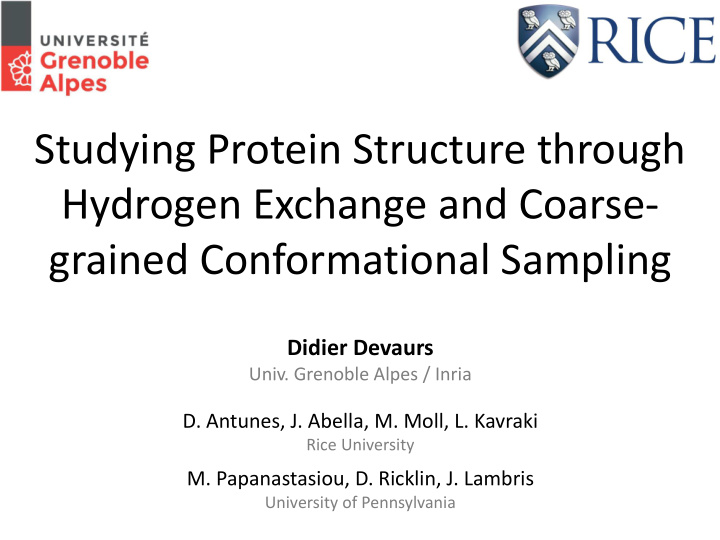



Studying Protein Structure through Hydrogen Exchange and Coarse- grained Conformational Sampling Didier Devaurs Univ. Grenoble Alpes / Inria D. Antunes, J. Abella, M. Moll, L. Kavraki Rice University M. Papanastasiou, D. Ricklin, J. Lambris University of Pennsylvania
Experimental techniques in structural biology highest resolution → structural model • X-ray crystallography → most structures in protein data bank (PDB) • nuclear magnetic resonance spectroscopy • cryo-electron microscopy … • hydrogen exchange / mass spectrometry lowest resolution
Objective: study a protein state described by low-resolution experimental data computational ? technique known 3D structural model low-resolution experimental data
Hydrogen exchange detected by mass spectrometry (HX-MS)
Hydrogen exchange detected by mass spectrometry (HX-MS)
Hydrogen exchange detected by mass spectrometry (HX-MS) Output: deuterium-uptake curves of peptides Deuterium uptake (%) Time
Hydrogen exchange detected by mass spectrometry (HX-MS) Output: deuterium-uptake curves of peptides
Studying a protein state described by experimental HX data computational technique conformational sampling known 3D structural model experimental HX data
Computational techniques for protein conformational sampling Molecular dynamics Markov-chain Monte Carlo Coarse-grained conformational sampling sampling-based planning algorithms (from robotics) → SIMS (structured intuitive move selector)
Structured intuitive move selector (SIMS) dihedral angle perturbation closed loop sampling rigid-body transformation energy minimization
Multi-resolution conformational sampling
Multi-resolution conformational sampling
Multi-resolution conformational sampling
How to assess the conformations generated by the sampling method? HX prediction model: conformation → HX data
Hydrogen-exchange prediction model Phenomenological approximation of protection from hydrogen exchange [Vendruscolo, Paci, Karplus] Idea: hydrogen exchange is influenced by residue — residue interactions - hydrogen bonds - packing density
Studying a protein state using HX data and conformational sampling coarse-grained conformational sampling SIMS known 3D structural model HX prediction model: experimental evaluate/bias sampling HX data
App. 1: Improve the fit to experimental hydrogen-exchange data phenomenological equation structurally-derived HX data crystal structure do not usually match [Devaurs, Antunes, Papanastasiou, Moll, Ricklin, experimentally-observed Lambris, Kavraki; Frontiers in HX data Molecular Biosciences, 2017]
Staphylococcal Nuclease (SN)
App. 2: Analyze the variability of a protein’s native state experimental HX data [Devaurs, Papanastasiou, Antunes, Abella, Moll, Ricklin, Lambris, Kavraki; Int J Comp Bio Drug Design, 2018]
Complement protein C3d Differences between the PDB and SIMS conformations characterize the variability of C3d's native state
App. 3: Generate a structural model for an unknown protein state coarse-grained conformational ? sampling known 3D unknown state structural model bias sampling experimental HX data [Devaurs, Antunes, Kavraki; Int J Molecular Sciences, 2018]
Complement protein iC3b Problem : no high-resolution structural model (but two competing low-resolution models) Solution : SIMS yields a conformation that helps validate one model (more than 1500 amino acids)
Conclusion Hydrogen exchange (HX) combined with coarse-grained conformational sampling is useful to study protein structure Current applications 1) improve the fit to experimental HX data 2) analyze the variability of a protein’s native state 3) generate a structural model for an unknown state
Thank you! Prof. Lydia Kavraki Prof. John Lambris
Recommend
More recommend